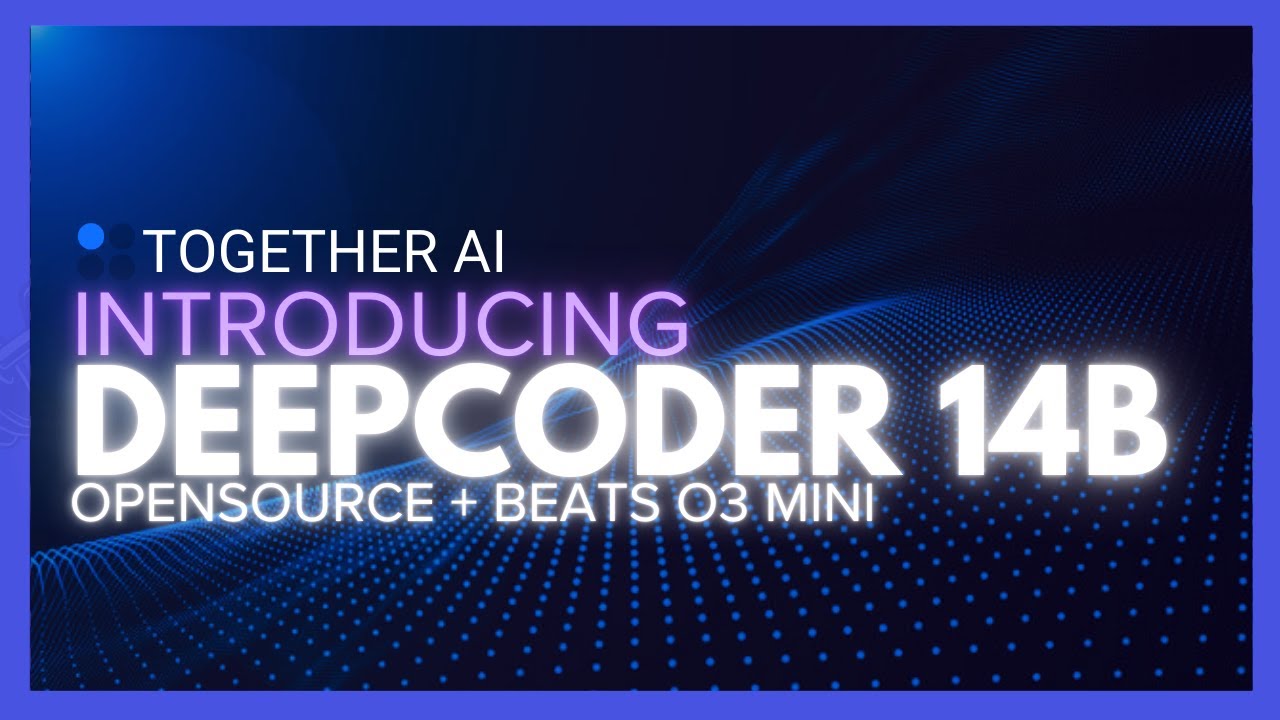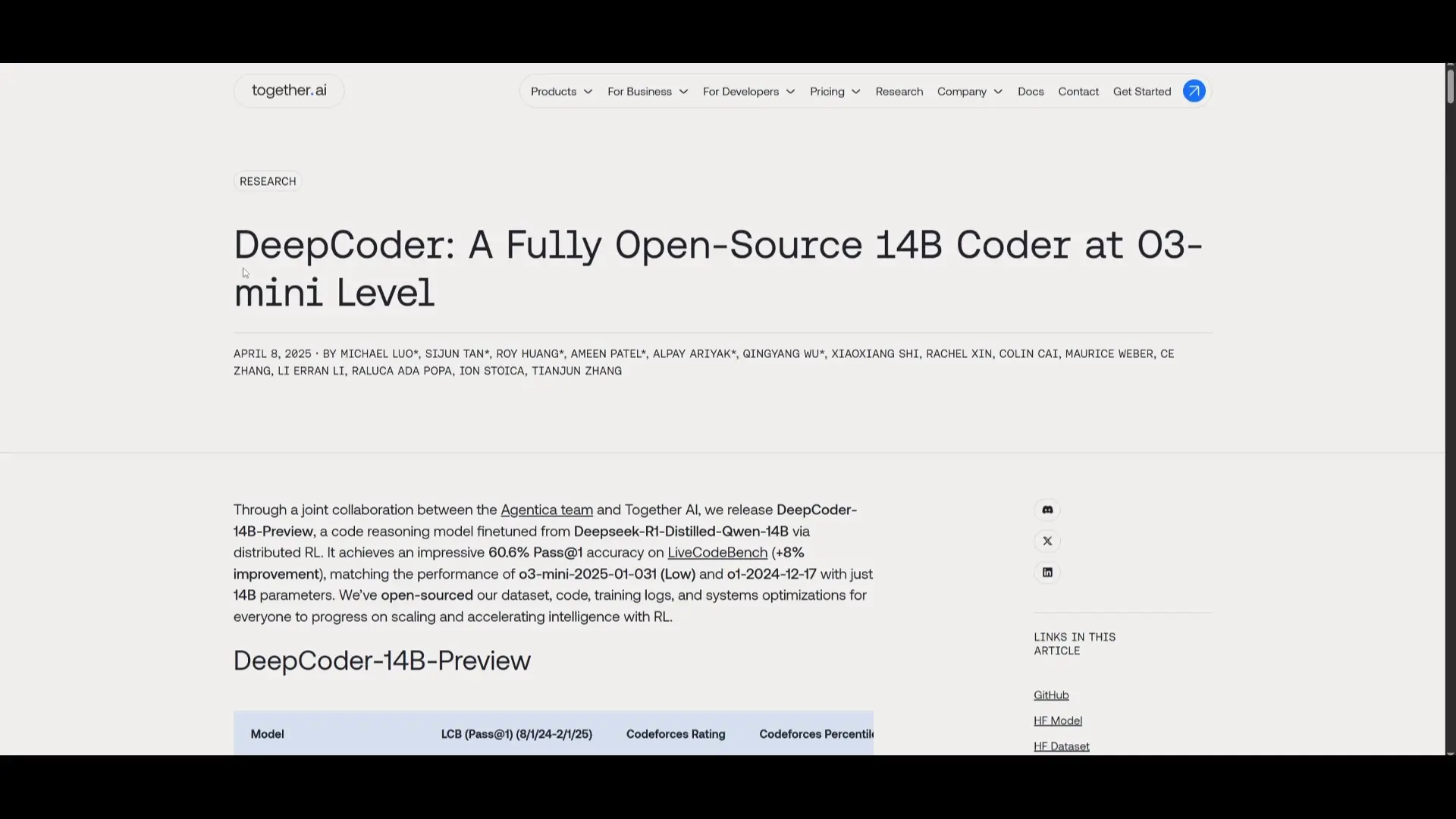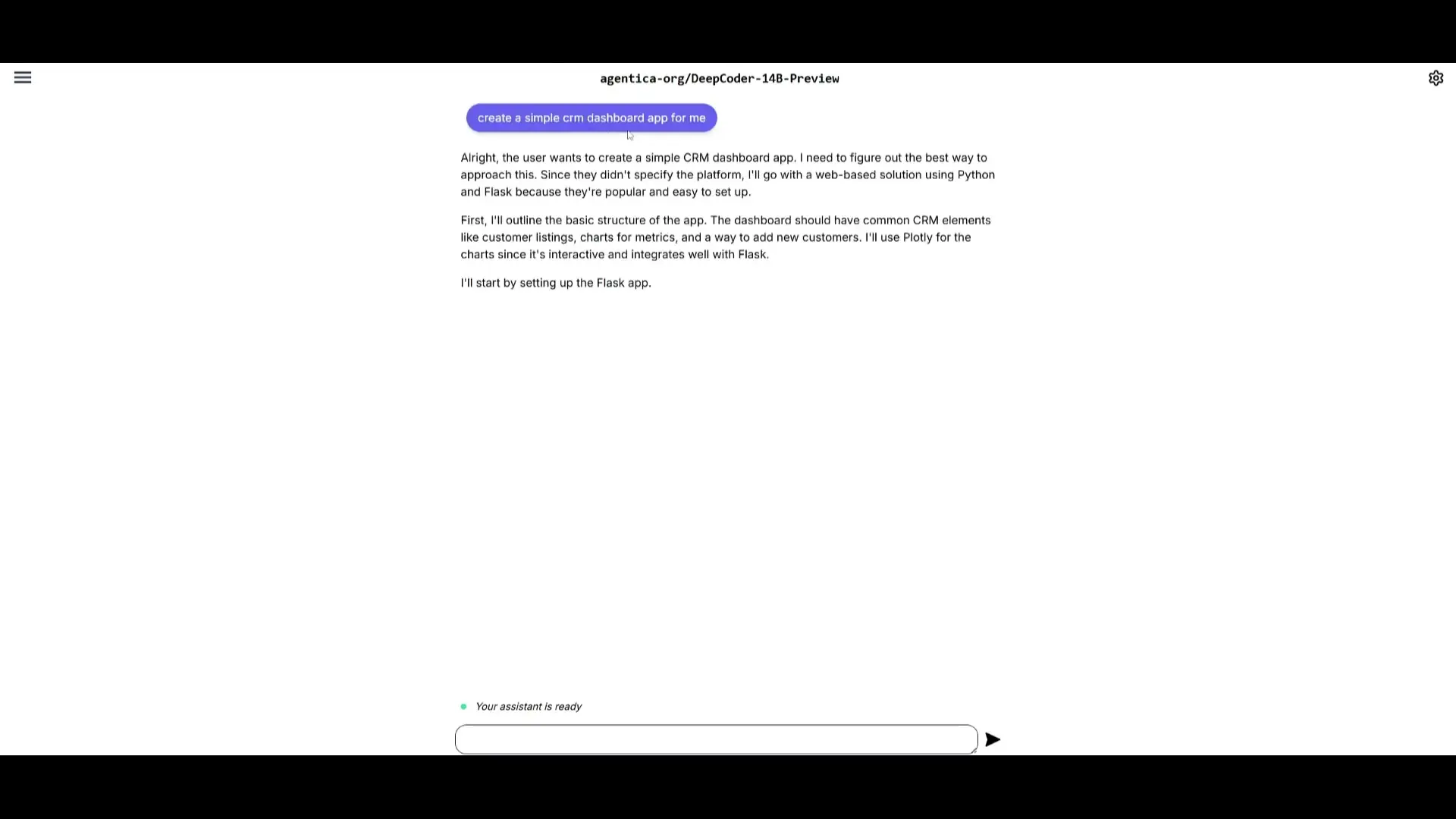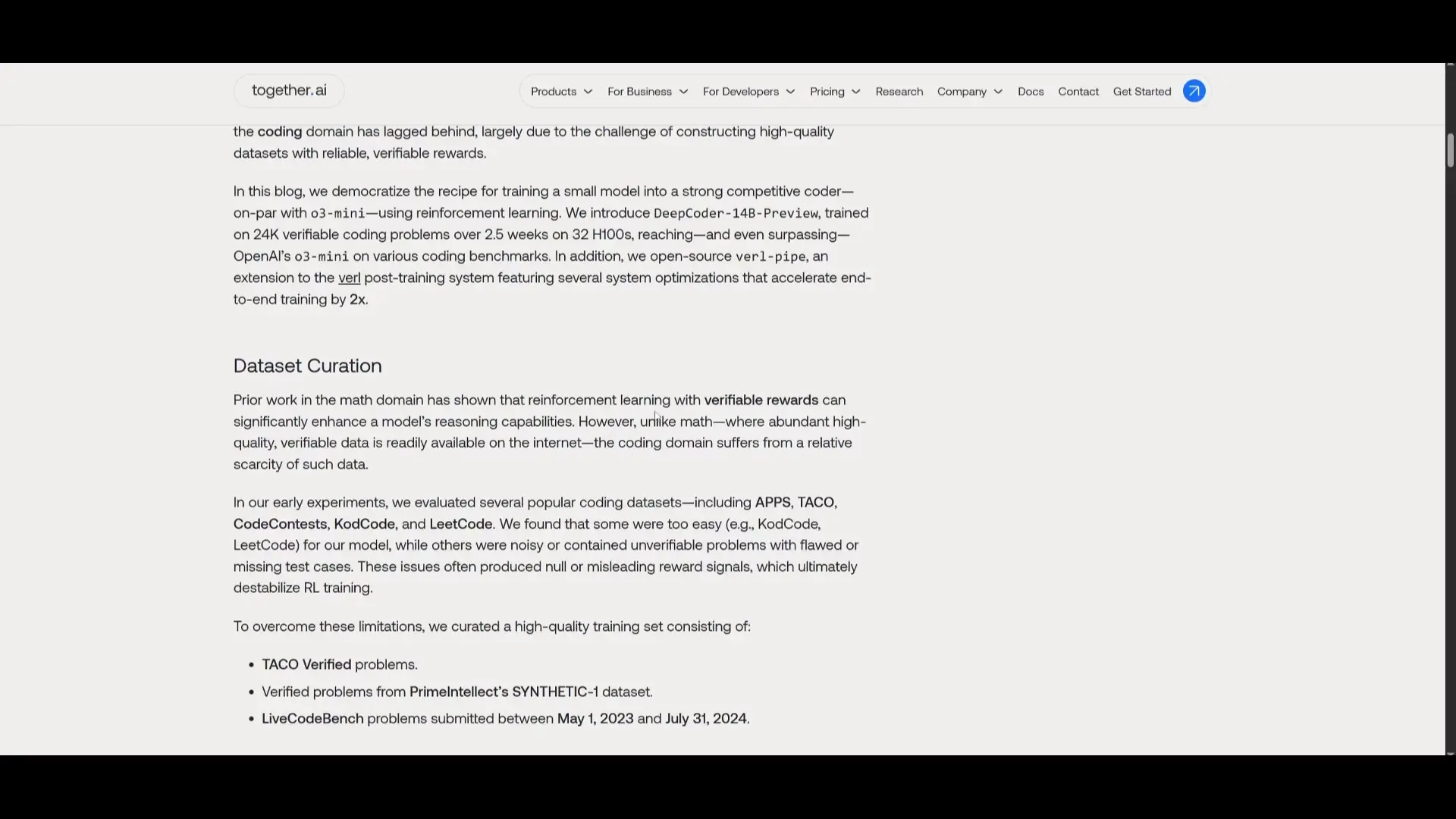
The AI development landscape has just witnessed a significant breakthrough with the release of DeepCoder 14B, a fully open-source AI coding model developed by Together AI in collaboration with Aentica. This compact yet powerful model is challenging the established players in the space with impressive performance metrics that match or even exceed those of proprietary models like OpenAI's GPT-3.5 Mini.
What Makes DeepCoder 14B Special?
Despite its relatively modest 14 billion parameter size, DeepCoder has achieved remarkable results that position it as a game-changer in the open-source AI community. The model was trained through distributed reinforcement learning on 24,000 verifiable coding problems over just 2.5 weeks using 32 H100 GPUs - an impressive feat of engineering efficiency.
- Achieves a 60.6% pass rate on HumanEval@1 benchmark
- Shows an 8% improvement over its base model
- Ranks in the 95.3 percentile on CodeForces
- Matches performance of OpenAI's GPT-3.5 Mini despite being fully open-source
What truly sets DeepCoder apart is its open-source nature - the model weights, training dataset, logs, and even the lightning-fast training pipeline called WorldPipe are all freely available to the community. This level of transparency and accessibility represents a significant step forward for democratizing advanced AI coding capabilities.
The Training Process Behind DeepCoder
The development team behind DeepCoder took a meticulous approach to ensure the model's quality and performance. Their methodology reveals valuable insights into what makes this model so effective despite its smaller size compared to industry giants.
- Curated a high-quality dataset of 24K verified coding problems from trusted sources
- Filtered out easy, duplicate, or broken problems to ensure reliable training
- Implemented an isolated code sandbox environment for running thousands of unit tests per batch
- Established a strict reward system where only code passing all tests earned credit
- Utilized a smarter training algorithm with gradual context length increases
- Introduced system optimizations that cut training time in half
This rigorous approach to training has resulted in a model that can handle inputs up to 64K tokens - modest by some standards but impressive given the parameter count. The team's focus on quality over quantity in both data and training methodology has clearly paid dividends in the final performance.

Benchmark Performance: How Does It Compare?
When compared against larger proprietary models, DeepCoder holds its ground impressively. It matches or sometimes exceeds the performance of OpenAI's GPT-3.5 Mini, and even outperforms some larger models on specific benchmarks. This is particularly notable given its significantly smaller parameter count and open-source nature.
The model's strong performance on coding benchmarks demonstrates that with the right training methodology, smaller models can achieve results comparable to much larger ones. This has significant implications for accessibility, as DeepCoder can run on more modest hardware configurations than many competing models.
Practical Applications: Testing DeepCoder in Real Scenarios
To evaluate DeepCoder beyond abstract benchmarks, we can examine its performance on practical coding tasks that developers might encounter in real-world scenarios.

When tasked with creating a simple CRM dashboard application, DeepCoder generates a complete project structure with functional code. The application successfully implements core features like adding customers and displaying totals - impressive for a 14B parameter model. While it may not generate every possible feature due to context window limitations, the code it produces is functional and well-structured.
For more complex tasks like SVG generation, DeepCoder shows both strengths and limitations. While it struggles with highly complex SVG tasks like creating an elegant butterfly illustration (a challenge even for much larger models), it successfully handles simpler SVG generation tasks like creating a basic smiley face.
Perhaps most importantly for developers, DeepCoder demonstrates strong capabilities in code debugging. When presented with faulty code containing multiple errors, it successfully identifies and fixes most issues, producing functional code that addresses the core problems.
# Example of DeepCoder fixing faulty code
# Original code with errors:
class Person:
def __init__(name, age):
self.name = name
self.age = "25"
def greeting():
print(f"Hello, my name is {self.name}")
# DeepCoder's corrected version:
class Person:
def __init__(self, name, age):
self.name = name
self.age = 25
def greeting(self):
return f"Hello, my name is {self.name}"How to Try DeepCoder 14B
For developers interested in experiencing DeepCoder firsthand, there are several straightforward options for accessing and using the model:
- Download from Hugging Face and run locally with LM Studio or Open WebUI
- Install via Ollama using a simple command line instruction
- Try it online through GLFF.hat, which offers free credits for testing open-source models
# Installing DeepCoder 14B through Ollama
ollama pull together/deepcoder-14bThis accessibility aligns perfectly with the model's open-source philosophy, making advanced AI coding capabilities available to developers regardless of their access to high-end hardware or proprietary platforms.

Limitations and Considerations
While DeepCoder represents a significant achievement in open-source AI development, it's important to acknowledge its limitations:
- 64K token context window is relatively modest compared to some larger models
- Struggles with highly complex creative coding tasks
- May not match the breadth of capabilities found in the largest proprietary models
Despite these limitations, the value proposition of DeepCoder is clear - it offers performance comparable to much larger proprietary models in a fully open-source package that can run on more accessible hardware. For many development tasks, these tradeoffs are well worth the benefits of transparency, accessibility, and local execution.
The Future of Open-Source AI Coding Models
DeepCoder 14B represents a significant milestone in the evolution of open-source AI coding models. By achieving performance parity with proprietary models while maintaining full transparency and accessibility, it demonstrates that the gap between open and closed AI systems is narrowing rapidly.
This development has profound implications for the democratization of AI capabilities. As models like DeepCoder continue to improve, they enable a wider range of developers and organizations to benefit from advanced code generation and assistance without dependency on proprietary platforms or substantial hardware investments.
For the developer community, the release of DeepCoder and its training methodology also provides valuable insights into efficient model training practices. The techniques used to achieve such impressive results with relatively modest parameters could inform future open-source AI development efforts across various domains.
Conclusion: A Significant Step Forward
DeepCoder 14B represents a significant leap forward for open-source AI coding models. By matching the performance of proprietary models like GPT-3.5 Mini with just 14 billion parameters and full open-source accessibility, it demonstrates that cutting-edge AI capabilities need not be limited to closed, resource-intensive systems.
For developers, researchers, and organizations invested in the open-source ecosystem, DeepCoder offers a compelling option for code generation, debugging, and assistance that can run on accessible hardware. As the model and its derivatives continue to evolve, they promise to further democratize advanced AI coding capabilities and push the boundaries of what's possible with open-source AI.
The release of DeepCoder reminds us that benchmark scores, while informative, are best complemented by hands-on testing in real-world scenarios. By making the model fully accessible, Together AI has invited the community to explore its capabilities firsthand and contribute to the ongoing evolution of open-source AI coding models.
Let's Watch!
DeepCoder 14B: The Open-Source AI Coding Model Challenging GPT-3.5 Mini
Ready to enhance your neural network?
Access our quantum knowledge cores and upgrade your programming abilities.
Initialize Training Sequence